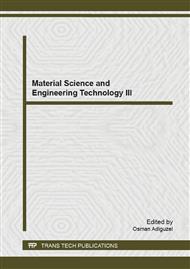p.261
p.268
p.272
p.276
p.280
p.286
p.290
p.294
p.299
Model of Phanerochaete chrysosporium Growth and Multisubstrate Degradation on the Biological Pretreatment of Water Hyacinth
Abstract:
A mathematical model was developed to predict the kinetics of Phanerochaete Chrysosporium growth and degradation of multisubstrate on a batch process with limited oxygen conditions, that of the effects the initial moisture content (IMC). The study was conducted on the pretreatment of water hyacinth (WH), to degrade the lignin in order to prepare the WH as a bioethanol feedstock. In this pretreatment, the fungus was inoculated on WH where it grew on the surface of the WH. The fungus consumed three different substrates contained in WH as carbon source, i.e. lignin, cellulose and hemicellulose. Experimental data are used to formulate multisubstrate degradation and fungal growth influenced by the IMC. The constant of fungal growth (μ) is influenced by the amount of the initial moisture content (IMC) following the equation with μmax value of 0.6887 day-1, KSL reached 0.7967 g.g dry weight-1, KsS is 0.7102 g.g dry weight-1, KsH is 0.1965 g.g dry weight-1, Yx/sL is 0.13 g.g dry weight of lignin-1, Yx/sS is 0.8560 g.g dry weight of cellulose-1, Yx/sH is 0.8999 g.g dry weight of hemicellulose-1 and the maximum of IMC (Wm) is 0.67 or 67%.
Info:
Periodical:
Pages:
280-285
Citation:
Online since:
April 2015
Authors:
Price:
Сopyright:
© 2015 Trans Tech Publications Ltd. All Rights Reserved
Share:
Citation:


